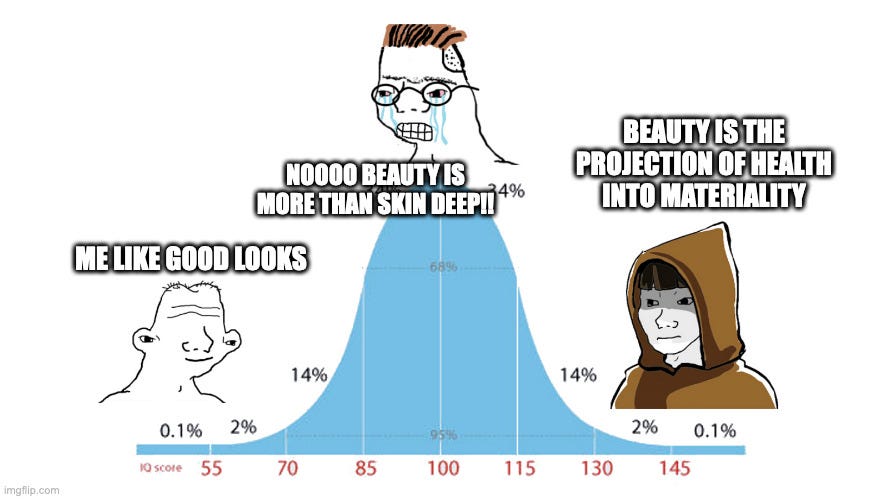“Beauty is more than skin deep” is a comforting idiom used to justify the ignorance of beauty.
What it actually means though is that “beauty is superficial, you should ignore it and it doesn’t matter if something/someone is ugly”.
This is a very dangerous concept and misses the point of beauty entirely. Beauty is one of the most important indicators of health, and is immensely useful if you fully understand it, which you will by the end of this post.
Some Math
To get there, we will take a quick diversion into some geometry and set theory. Remember when you asked “where are we going to use this?” in math class 15 years ago?
This is where. In a substack about health and tanning (it will all be worth it I promise).
Objects and Surfaces
There is an interesting relationship between surfaces and their corresponding objects.
I’ll start with a simple example: a disc in 2D space (which in math means all the points within a given radius).
It is a 2D object, meaning that you need two numbers to describe every point in the disc. x and y. Or r and θ
A surface, also known as a boundary, is all the points on the “outside” of the object. In this example, the boundary is the circle of points exactly one unit from the center.
The boundary can be thought of as the shell, the lining, or the surface of the object itself.
While the disc is 2D, the interesting part about the surface is that it’s 1D— if I give you this circle, you only need one number to tell me where any given point is (e.g., the angle from horizontal (θ)).
The fact that the surface is 1D and the object is 2D reveals an important truth — the surfaces of all objects are always one dimension lower than the object itself.
Just think of the earth — a 3D ball, and its surface — the ground. The ground is 2D, because you only need two numbers to define every point on it (i.e., latitude and longitude).
2D objects can be drawn on paper, which is exactly what a map is:
But the earth itself has three numbers — latitude, longitude, and altitude, which tells you the distance from the center of the earth (yes altitude can specify a point underground).
Dimensions and Complexity
So we know that objects which are n-dimensional have surfaces or boundaries which are always (n-1)-dimensional.
Why does that matter?
Because, as you add dimensions, you add complexity.
A circle has infinite points, but what about a sphere? It has even more infinite points— it contains an entire additional infinite dimension of numbers.
Moving beyond the math, this really means that if you want to fully understand an object in all its complexity, you need to consider it in all its dimensions. And if you are looking at the shell of it in fewer dimensions, you will miss out on a lot of complexity.
Examples:
Sculptures are more complex than paintings. Real life (3D) is more complex than television (2D). The body (3D) is more complex than its skin (2D). The earth (3D) is more complex than a map (2D).
What you can see
It’s important to note that in 3D space, the only things you can see are 2D surfaces.
Look around you. The phone screen?
2D.
Your skin?
2D.
The table top?
2D.
And if you were to cut into any of those things, you wouldn’t see anything 3D— just a new 2D slice of the thing you cut up.
It is a fundamental limitation of being a human in physical 3D reality that you can only see the 2D surfaces of things— nothing more.
Superficiality
Superficiality literally means “above” (super-) “the face/surface” (-facies).
That face, as we now know, is the boundary of the object. When you are superficial it means you consider an object from above the boundary—i.e., outside the object, and pay no attention to what’s inside (i.e., in higher dimensions).
As you’ve seen, you can only ever see any object’s 2D surface. So if you don’t attempt to look past that surface, which is a natural physical limitation, you’ll end up with a superficial reading of the object itself—i.e., you will miss out on what’s going on in higher dimensions.
From the outside, a 2D thing might look good.
But what about that 3rd dimension— that entire realm of infinite complexity contained in the object?
A superficial view misses out on that complexity.
This is why people think plastic surgery, fake tans, makeup, and synthetic fiber clothing look good on a person— they are looking at the person only from the outside.
They miss the fact that plastic surgery is making your cells sclerotic and sick. Miss the fact that makeup is hiding nutrient deficiencies that manifest as acne. Miss the fact that synthic clothing is causing hormonal imbalances and reproductive stress.
But as you’ve seen, you can only ever see any object’s 2D surface.
How is it possible to be anything other than superficial?
Seeing Higher Dimensions
Concepts like health are “higher dimensional”. This simply means they are too complex to be a literal part of physical, 3D reality.
So how can you “see” higher dimensions? How can you “see” health?
It can never itself be seen, but if you understand what it means, you can look for indicators of it in the dimensions that you can physically see (i.e., 2D).
In my article about indicators of poor health, I listed a few visual clues that a body is unhealthy.
You can’t see good or bad health directly, but you can see evidence of it.
Bad skin, excess body fat, poor muscle tone, etc.
And it turns out that all of those visual clues of poor health are also visually ugly.
But when the body is healthy, those things become visually beautiful. Is this a coincidence? Of course not.
What beauty means
This leads us to the most important fact about health and beauty:
Beauty is the manifestation of health into physical reality.
When you are healthy, it means that your biology is functioning according to its structure.
Through generations of evolution, we have come to identify indicators of peak functioning in each other as beautiful and therefore desirable.
The sage on the right knows how it works— if you understand that health, a higher dimensional concept, manifests itself visually as the indicator known as beauty, then you will recognize beauty as a tool to better understanding the health of a body.
The challenged fellow half gets it. He knows beauty when he sees it and thinks it’s desirable. But his problem is that he is unable to see into higher dimensions— past the boundary and into the object itself— and so he doesn’t understand that beauty comes from a deeper principle.
He will be easily fooled by superficial beauty, i.e. a mimicry of those indicators of health that are not connected to any true principle, like in the woman above, and will consider beautiful things like makeup, plastic clothing, breast implants, lip fillers, and all manner of grotesque substitutions for real beauty.
The error made by the “beauty is more than skin deep” camp (the midwit in the above meme) is that he ignores these important indicators and is unable to evalute true health or quality.

This is most likely a result of a fake world — the midwit is smart enough to know that appearances don’t make something true (i.e., the surface doesn’t fully determine or represent the object) — and so he rejects appearances entirely for fear of making a mistake in judgment.
The pursuit of beauty
In conclusion, the pursuit and desire for physical beauty is only superficial when you ignore the meaning behind the beauty, namely, health.
The true goal is health, and beauty is the guidepost to get you there.
Ignoring this fact results in a vision of beauty that is indeed superficial, as there is nothing behind it other than mere appearances.
And it results in a concept of “health” completely abstract, reductionist, and detached from any tangible concepts.
Beauty in the world
As we have lost beauty, so too have we forgotten about health.
This is why I spread my message about health through the lens of beauty— not superficial, but one connected to the real divine principle that is the source of health.
Beauty is inherently appealing, so by strengthening this connection in the minds of people, we will teach them to care about health as well.
Takeaway
This is an important goal, and something everyone can participate in. Do not allow people to tell you looks don’t matter. Exlain why they do in a rational way.
Demonstrate by your example— how you take care of yourself and your surroundings— that beauty leads to a higher principle.
Embody that in every way you can. An example of this is the branding we chose to use for MASA Chips… the beautiful imagery is directly connected to the higher principle of health in the ingredients we use to make our tortilla chips.
The more that people see examples of this, the better.
Summary
Complex objects are only visible through their lower-complexity surfaces
Looking at merely the surface of an object (superficiality) misses the complexity of objects
Beauty is visual, but it comes from a higher complexity principle which is health
Focus on beauty without the principle of health is superficial and useless
Beauty, when connected in the mind to health, is a very useful visual indicator of health
Displaying beauty in its connection to health makes health inherently more appealing
Please leave a question if you want further clarification— I know it was complicated but this is a super important point.












